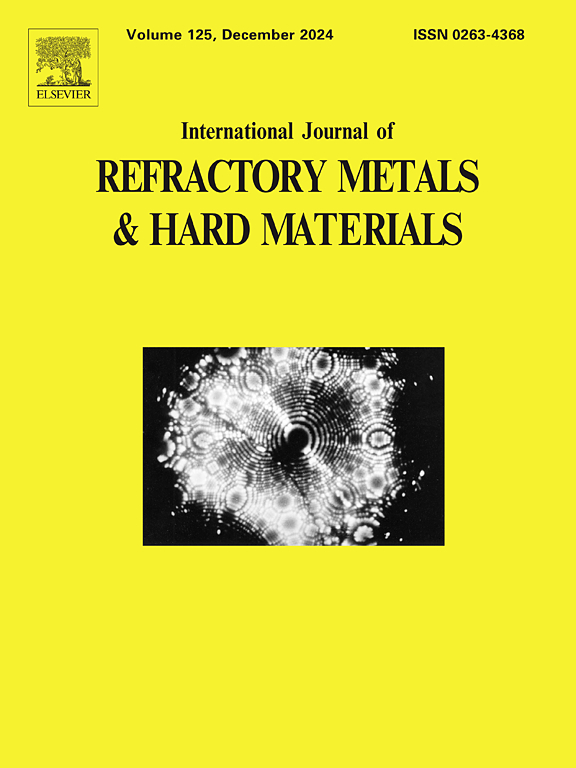A discrete element method for mechanical behavior analysis of single-crystal silicon at different temperatures
IF 4.2
2区 材料科学
Q2 MATERIALS SCIENCE, MULTIDISCIPLINARY
International Journal of Refractory Metals & Hard Materials
Pub Date : 2025-05-07
DOI:10.1016/j.ijrmhm.2025.107223
引用次数: 0
Abstract
Single-crystal silicon (sc-Si) is a typical infrared material widely used in industries such as semiconductors and infrared imaging. At room temperature, sc-Si exhibits high hardness and brittleness, making it prone to defects like collapse and crack during processing. However, at elevated temperatures, sc-Si can undergo plastic deformation, which is of great significance for improving its manufacturing accuracy. Therefore, the effect of temperature on mechanical behavior of sc-Si was analyzed. Three-dimensional discrete element method (DEM) was used to simulate the effect of temperature on crack generation and propagation during the deformation of sc-Si. Then, nanoindentation and scratching tests were performed to compare the material's mechanical properties and removal processes at various temperatures. The results shows that the ductile machinability and the inhibition of crack propagation improve with increasing temperature. As the temperature rises, the hardness decreases, while the elastic modulus increases. The critical load required to induce cracks increases from 60 mN at room temperature to 100 mN at 400 °C. Elevated temperatures enhance the depth of the ductile-brittle transition of sc-Si, helping to suppress crack formation during scratching. These findings provide valuable insights into the deformation behavior of sc-Si, offering support for the manufacturing of sc-Si.

单晶硅在不同温度下力学行为分析的离散元法
单晶硅(sc-Si)是一种典型的红外材料,广泛应用于半导体和红外成像等行业。在室温下,sc-Si具有较高的硬度和脆性,在加工过程中容易出现塌陷和裂纹等缺陷。然而,sc-Si在高温下会发生塑性变形,这对提高其制造精度具有重要意义。因此,分析了温度对sc-Si力学行为的影响。采用三维离散元法(DEM)模拟了温度对sc-Si变形过程中裂纹产生和扩展的影响。然后,进行了纳米压痕和划痕测试,比较了材料在不同温度下的机械性能和去除过程。结果表明,随着温度的升高,合金的塑性可加工性和裂纹扩展的抑制能力有所提高。随着温度的升高,硬度降低,而弹性模量增大。产生裂纹所需的临界载荷从室温下的60 mN增加到400℃下的100 mN。升高的温度增强sc-Si的韧性-脆性转变的深度,有助于抑制划痕过程中的裂纹形成。这些发现为sc-Si的变形行为提供了有价值的见解,为sc-Si的制造提供了支持。
本文章由计算机程序翻译,如有差异,请以英文原文为准。
求助全文
约1分钟内获得全文
求助全文
来源期刊
CiteScore
7.00
自引率
13.90%
发文量
236
审稿时长
35 days
期刊介绍:
The International Journal of Refractory Metals and Hard Materials (IJRMHM) publishes original research articles concerned with all aspects of refractory metals and hard materials. Refractory metals are defined as metals with melting points higher than 1800 °C. These are tungsten, molybdenum, chromium, tantalum, niobium, hafnium, and rhenium, as well as many compounds and alloys based thereupon. Hard materials that are included in the scope of this journal are defined as materials with hardness values higher than 1000 kg/mm2, primarily intended for applications as manufacturing tools or wear resistant components in mechanical systems. Thus they encompass carbides, nitrides and borides of metals, and related compounds. A special focus of this journal is put on the family of hardmetals, which is also known as cemented tungsten carbide, and cermets which are based on titanium carbide and carbonitrides with or without a metal binder. Ceramics and superhard materials including diamond and cubic boron nitride may also be accepted provided the subject material is presented as hard materials as defined above.

 求助内容:
求助内容: 应助结果提醒方式:
应助结果提醒方式:


